An official website of the United States government
 United States Department of Labor
United States Department of Labor
Directly supervise and coordinate the activities of agricultural, forestry, aquacultural, and related workers. Excludes "First-Line Supervisors of Landscaping, Lawn Service, and Groundskeeping Workers" (37-1012).
Employment estimate and mean wage estimates for First-Line Supervisors of Farming, Fishing, and Forestry Workers:
| Employment (1) | Employment RSE (3) |
Mean hourly wage |
Mean annual wage (2) |
Wage RSE (3) |
|---|---|---|---|---|
| 22,640 | 2.6 % | $ 26.16 | $ 54,420 | 0.8 % |
Percentile wage estimates for First-Line Supervisors of Farming, Fishing, and Forestry Workers:
| Percentile | 10% | 25% | 50% (Median) |
75% | 90% |
|---|---|---|---|---|---|
| Hourly Wage | $ 15.26 | $ 18.43 | $ 24.08 | $ 31.91 | $ 39.95 |
| Annual Wage (2) | $ 31,730 | $ 38,340 | $ 50,080 | $ 66,380 | $ 83,090 |
Industries with the highest published employment and wages for First-Line Supervisors of Farming, Fishing, and Forestry Workers are provided. For a list of all industries with employment in First-Line Supervisors of Farming, Fishing, and Forestry Workers, see the Create Customized Tables function.
Industries with the highest levels of employment in First-Line Supervisors of Farming, Fishing, and Forestry Workers:
| Industry | Employment (1) | Percent of industry employment | Hourly mean wage | Annual mean wage (2) |
|---|---|---|---|---|
| Support Activities for Crop Production | 9,530 | 2.72 | $ 24.52 | $ 51,000 |
| Logging | 2,030 | 4.24 | $ 31.26 | $ 65,020 |
| State Government, excluding schools and hospitals (OEWS Designation) | 1,490 | 0.07 | $ 26.42 | $ 54,960 |
| Merchant Wholesalers, Nondurable Goods (4241, 4247, and 4249 only) | 1,440 | 0.27 | $ 27.00 | $ 56,170 |
| Support Activities for Animal Production | 1,060 | 3.33 | $ 25.80 | $ 53,650 |
Industries with the highest concentration of employment in First-Line Supervisors of Farming, Fishing, and Forestry Workers:
| Industry | Employment (1) | Percent of industry employment | Hourly mean wage | Annual mean wage (2) |
|---|---|---|---|---|
| Logging | 2,030 | 4.24 | $ 31.26 | $ 65,020 |
| Support Activities for Animal Production | 1,060 | 3.33 | $ 25.80 | $ 53,650 |
| Support Activities for Crop Production | 9,530 | 2.72 | $ 24.52 | $ 51,000 |
| Farm Product Raw Material Merchant Wholesalers | 370 | 0.53 | $ 25.43 | $ 52,890 |
| Lawn and Garden Equipment and Supplies Stores | 740 | 0.45 | $ 23.71 | $ 49,310 |
Top paying industries for First-Line Supervisors of Farming, Fishing, and Forestry Workers:
| Industry | Employment (1) | Percent of industry employment | Hourly mean wage | Annual mean wage (2) |
|---|---|---|---|---|
| Business, Professional, Labor, Political, and Similar Organizations | 60 | 0.01 | $ 35.51 | $ 73,860 |
| Federal Executive Branch (OEWS Designation) | 40 | (7) | $ 35.49 | $ 73,820 |
| Merchant Wholesalers, Nondurable Goods (4244 and 4248 only) | 350 | 0.04 | $ 33.53 | $ 69,740 |
| Sawmills and Wood Preservation | 90 | 0.11 | $ 33.09 | $ 68,830 |
| Scientific Research and Development Services | 170 | 0.02 | $ 32.97 | $ 68,590 |
States and areas with the highest published employment, location quotients, and wages for First-Line Supervisors of Farming, Fishing, and Forestry Workers are provided. For a list of all areas with employment in First-Line Supervisors of Farming, Fishing, and Forestry Workers, see the Create Customized Tables function.
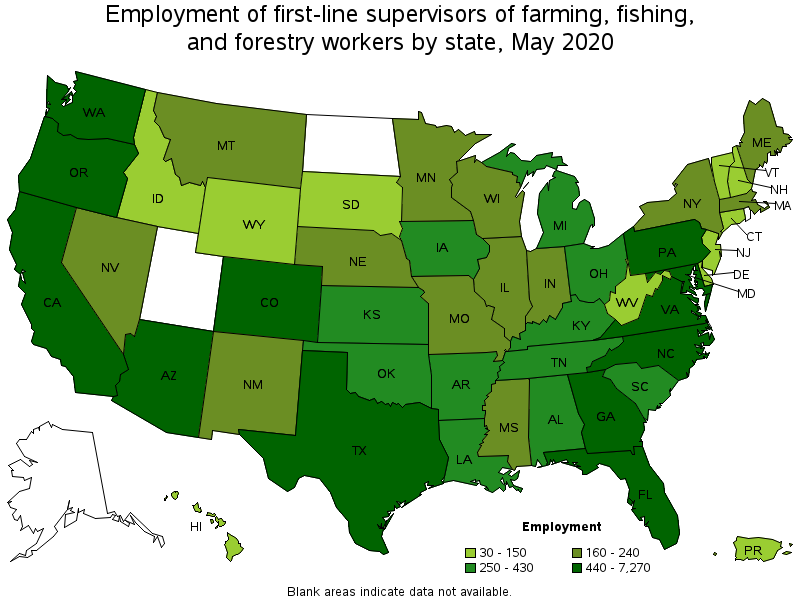
States with the highest employment level in First-Line Supervisors of Farming, Fishing, and Forestry Workers:
| State | Employment (1) | Employment per thousand jobs | Location quotient (9) | Hourly mean wage | Annual mean wage (2) |
|---|---|---|---|---|---|
| California | 7,270 | 0.44 | 2.72 | $ 24.75 | $ 51,490 |
| Washington | 1,240 | 0.39 | 2.38 | $ 27.73 | $ 57,680 |
| Florida | 1,080 | 0.13 | 0.79 | $ 26.81 | $ 55,760 |
| Texas | 1,010 | 0.08 | 0.52 | $ 24.10 | $ 50,140 |
| Oregon | 840 | 0.46 | 2.84 | $ 25.92 | $ 53,910 |

States with the highest concentration of jobs and location quotients in First-Line Supervisors of Farming, Fishing, and Forestry Workers:
| State | Employment (1) | Employment per thousand jobs | Location quotient (9) | Hourly mean wage | Annual mean wage (2) |
|---|---|---|---|---|---|
| Oregon | 840 | 0.46 | 2.84 | $ 25.92 | $ 53,910 |
| California | 7,270 | 0.44 | 2.72 | $ 24.75 | $ 51,490 |
| Montana | 190 | 0.41 | 2.55 | $ 27.27 | $ 56,730 |
| Washington | 1,240 | 0.39 | 2.38 | $ 27.73 | $ 57,680 |
| Vermont | 90 | 0.30 | 1.87 | $ 20.96 | $ 43,590 |
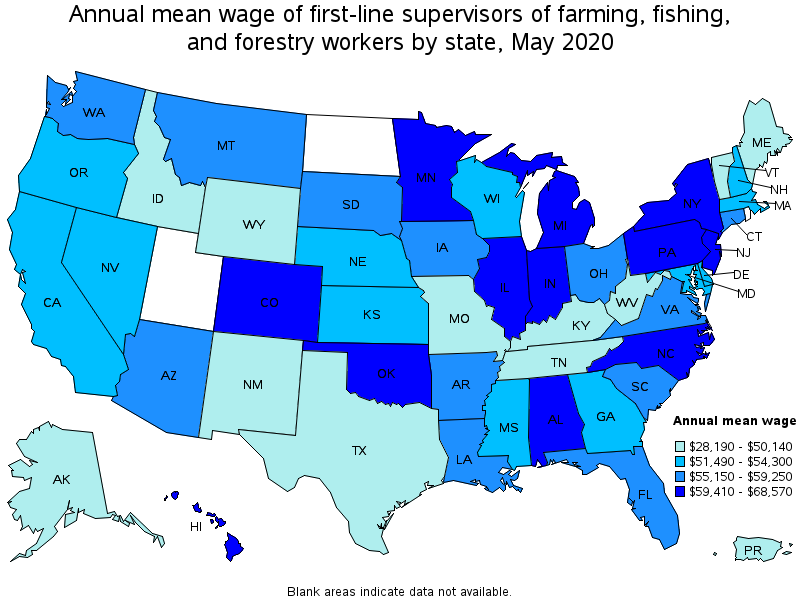
Top paying states for First-Line Supervisors of Farming, Fishing, and Forestry Workers:
| State | Employment (1) | Employment per thousand jobs | Location quotient (9) | Hourly mean wage | Annual mean wage (2) |
|---|---|---|---|---|---|
| Hawaii | 150 | 0.26 | 1.59 | $ 32.96 | $ 68,570 |
| Illinois | 190 | 0.03 | 0.21 | $ 32.07 | $ 66,710 |
| New York | 240 | 0.03 | 0.17 | $ 31.98 | $ 66,530 |
| Michigan | 270 | 0.07 | 0.42 | $ 30.61 | $ 63,660 |
| New Jersey | 150 | 0.04 | 0.25 | $ 30.36 | $ 63,150 |
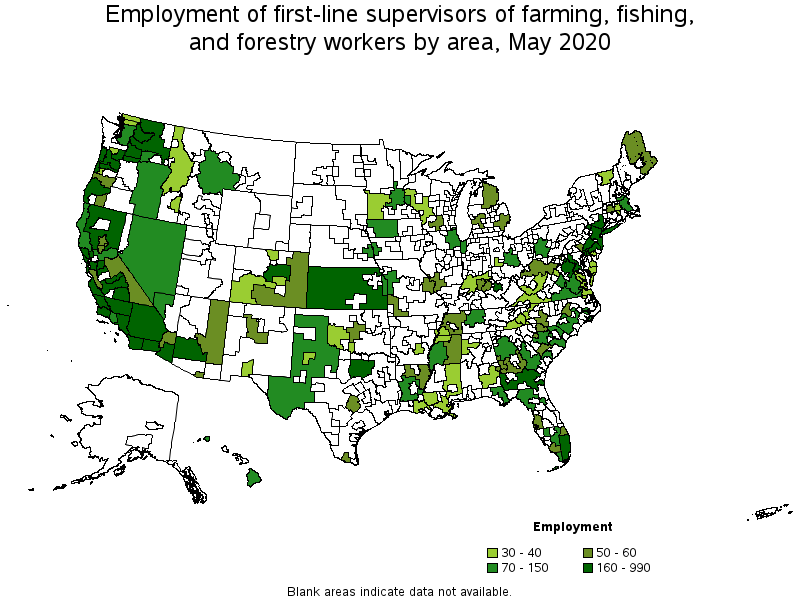
Metropolitan areas with the highest employment level in First-Line Supervisors of Farming, Fishing, and Forestry Workers:
| Metropolitan area | Employment (1) | Employment per thousand jobs | Location quotient (9) | Hourly mean wage | Annual mean wage (2) |
|---|---|---|---|---|---|
| Salinas, CA | 990 | 5.77 | 35.48 | $ 25.02 | $ 52,040 |
| Bakersfield, CA | 760 | 2.48 | 15.24 | $ 24.56 | $ 51,090 |
| Visalia-Porterville, CA | 690 | 4.66 | 28.61 | $ 19.88 | $ 41,350 |
| Fresno, CA | 580 | 1.55 | 9.54 | $ 22.85 | $ 47,520 |
| Santa Maria-Santa Barbara, CA | 490 | 2.70 | 16.61 | $ 25.87 | $ 53,810 |
| Yuma, AZ | 430 | 7.03 | 43.19 | $ 28.52 | $ 59,330 |
| Miami-Fort Lauderdale-West Palm Beach, FL | 330 | 0.13 | 0.80 | $ 36.12 | $ 75,140 |
| Napa, CA | 320 | 4.62 | 28.40 | $ 28.85 | $ 60,010 |
| Stockton-Lodi, CA | 320 | 1.28 | 7.88 | $ 26.17 | $ 54,440 |
| El Centro, CA | 310 | 5.38 | 33.05 | $ 27.72 | $ 57,650 |
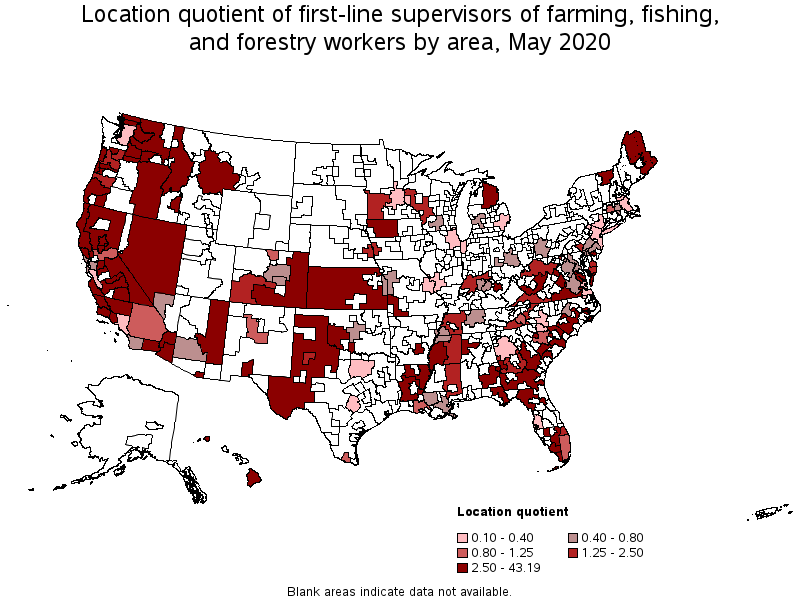
Metropolitan areas with the highest concentration of jobs and location quotients in First-Line Supervisors of Farming, Fishing, and Forestry Workers:
| Metropolitan area | Employment (1) | Employment per thousand jobs | Location quotient (9) | Hourly mean wage | Annual mean wage (2) |
|---|---|---|---|---|---|
| Yuma, AZ | 430 | 7.03 | 43.19 | $ 28.52 | $ 59,330 |
| Madera, CA | 290 | 6.41 | 39.39 | $ 24.53 | $ 51,010 |
| Salinas, CA | 990 | 5.77 | 35.48 | $ 25.02 | $ 52,040 |
| El Centro, CA | 310 | 5.38 | 33.05 | $ 27.72 | $ 57,650 |
| Visalia-Porterville, CA | 690 | 4.66 | 28.61 | $ 19.88 | $ 41,350 |
| Napa, CA | 320 | 4.62 | 28.40 | $ 28.85 | $ 60,010 |
| Wenatchee, WA | 190 | 4.24 | 26.04 | $ 22.55 | $ 46,900 |
| Yakima, WA | 250 | 2.72 | 16.72 | $ 27.76 | $ 57,740 |
| Santa Maria-Santa Barbara, CA | 490 | 2.70 | 16.61 | $ 25.87 | $ 53,810 |
| Bakersfield, CA | 760 | 2.48 | 15.24 | $ 24.56 | $ 51,090 |
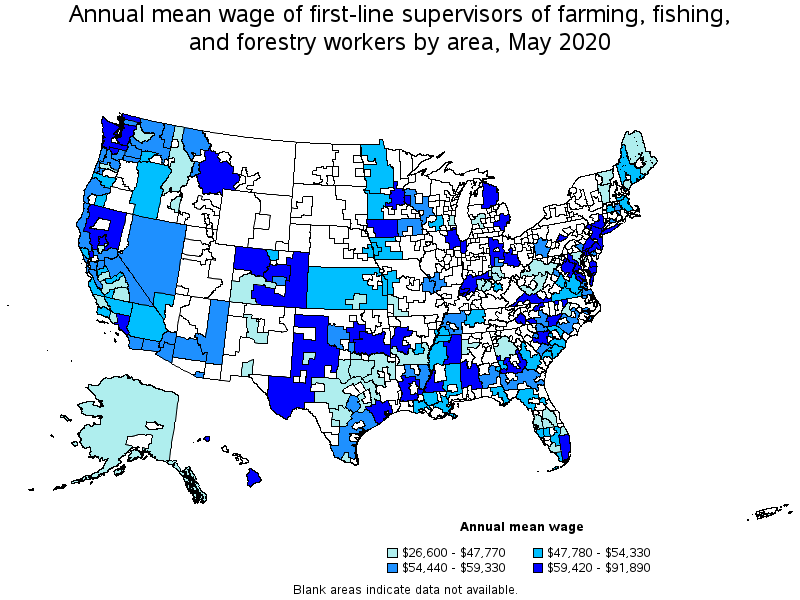
Top paying metropolitan areas for First-Line Supervisors of Farming, Fishing, and Forestry Workers:
| Metropolitan area | Employment (1) | Employment per thousand jobs | Location quotient (9) | Hourly mean wage | Annual mean wage (2) |
|---|---|---|---|---|---|
| Oklahoma City, OK | 60 | 0.10 | 0.59 | $ 36.65 | $ 76,240 |
| Detroit-Warren-Dearborn, MI | 50 | 0.03 | 0.16 | $ 36.30 | $ 75,500 |
| Miami-Fort Lauderdale-West Palm Beach, FL | 330 | 0.13 | 0.80 | $ 36.12 | $ 75,140 |
| Columbia, SC | 70 | 0.18 | 1.13 | $ 35.05 | $ 72,910 |
| Longview, WA | 30 | 0.85 | 5.21 | $ 34.57 | $ 71,910 |
| Minneapolis-St. Paul-Bloomington, MN-WI | 80 | 0.05 | 0.28 | $ 33.66 | $ 70,010 |
| Seattle-Tacoma-Bellevue, WA | 90 | 0.05 | 0.29 | $ 33.30 | $ 69,270 |
| Columbus, OH | 110 | 0.11 | 0.66 | $ 32.92 | $ 68,470 |
| Bellingham, WA | 40 | 0.47 | 2.91 | $ 32.47 | $ 67,540 |
| Evansville, IN-KY | (8) | (8) | (8) | $ 31.16 | $ 64,820 |
Nonmetropolitan areas with the highest employment in First-Line Supervisors of Farming, Fishing, and Forestry Workers:
| Nonmetropolitan area | Employment (1) | Employment per thousand jobs | Location quotient (9) | Hourly mean wage | Annual mean wage (2) |
|---|---|---|---|---|---|
| Eastern Washington nonmetropolitan area | 300 | 3.28 | 20.13 | $ 28.01 | $ 58,260 |
| Kansas nonmetropolitan area | 270 | 0.72 | 4.46 | $ 25.35 | $ 52,740 |
| South Georgia nonmetropolitan area | 180 | 0.97 | 5.96 | $ 27.52 | $ 57,250 |
| North Valley-Northern Mountains Region of California nonmetropolitan area | 170 | 1.71 | 10.52 | $ 31.62 | $ 65,780 |
| Coast Oregon nonmetropolitan area | 160 | 1.49 | 9.16 | $ 27.70 | $ 57,620 |
Nonmetropolitan areas with the highest concentration of jobs and location quotients in First-Line Supervisors of Farming, Fishing, and Forestry Workers:
| Nonmetropolitan area | Employment (1) | Employment per thousand jobs | Location quotient (9) | Hourly mean wage | Annual mean wage (2) |
|---|---|---|---|---|---|
| Eastern Washington nonmetropolitan area | 300 | 3.28 | 20.13 | $ 28.01 | $ 58,260 |
| North Valley-Northern Mountains Region of California nonmetropolitan area | 170 | 1.71 | 10.52 | $ 31.62 | $ 65,780 |
| Coast Oregon nonmetropolitan area | 160 | 1.49 | 9.16 | $ 27.70 | $ 57,620 |
| Northeast South Carolina nonmetropolitan area | 120 | 1.22 | 7.49 | $ 25.37 | $ 52,770 |
| Hawaii / Kauai nonmetropolitan area | 110 | 1.18 | 7.26 | $ 34.44 | $ 71,640 |
Top paying nonmetropolitan areas for First-Line Supervisors of Farming, Fishing, and Forestry Workers:
| Nonmetropolitan area | Employment (1) | Employment per thousand jobs | Location quotient (9) | Hourly mean wage | Annual mean wage (2) |
|---|---|---|---|---|---|
| Northwest Colorado nonmetropolitan area | (8) | (8) | (8) | $ 44.18 | $ 91,890 |
| Western Washington nonmetropolitan area | (8) | (8) | (8) | $ 40.05 | $ 83,300 |
| Northeast Lower Peninsula of Michigan nonmetropolitan area | 50 | 0.75 | 4.61 | $ 37.07 | $ 77,100 |
| West Arkansas nonmetropolitan area | (8) | (8) | (8) | $ 34.86 | $ 72,510 |
| Hawaii / Kauai nonmetropolitan area | 110 | 1.18 | 7.26 | $ 34.44 | $ 71,640 |
These estimates are calculated with data collected from employers in all industry sectors, all metropolitan and nonmetropolitan areas, and all states and the District of Columbia. The top employment and wage figures are provided above. The complete list is available in the downloadable XLS files.
The percentile wage estimate is the value of a wage below which a certain percent of workers fall. The median wage is the 50th percentile wage estimate—50 percent of workers earn less than the median and 50 percent of workers earn more than the median. More about percentile wages.
(1) Estimates for detailed occupations do not sum to the totals because the totals include occupations not shown separately. Estimates do not include self-employed workers.
(2) Annual wages have been calculated by multiplying the hourly mean wage by a "year-round, full-time" hours figure of 2,080 hours; for those occupations where there is not an hourly wage published, the annual wage has been directly calculated from the reported survey data.
(3) The relative standard error (RSE) is a measure of the reliability of a survey statistic. The smaller the relative standard error, the more precise the estimate.
(7) The value is less than .005 percent of industry employment.
(8) Estimate not released.
(9) The location quotient is the ratio of the area concentration of occupational employment to the national average concentration. A location quotient greater than one indicates the occupation has a higher share of employment than average, and a location quotient less than one indicates the occupation is less prevalent in the area than average.
Other OEWS estimates and related information:
May 2020 National Occupational Employment and Wage Estimates
May 2020 State Occupational Employment and Wage Estimates
May 2020 Metropolitan and Nonmetropolitan Area Occupational Employment and Wage Estimates
May 2020 National Industry-Specific Occupational Employment and Wage Estimates
Last Modified Date: March 31, 2021